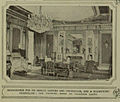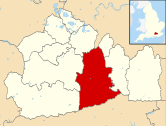
Dorking is a market town in Surrey in South East England, about 21 mi (34 km) south of London. It is in Mole Valley District and the council headquarters are to the east of the centre. The High Street runs roughly east–west, parallel to the Pipp Brook and along the northern face of an outcrop of Lower Greensand. The town is surrounded on three sides by the Surrey Hills Area of Outstanding Natural Beauty and is close to Box Hill and Leith Hill.

Great Bookham is a village in Surrey, England, one of six semi-urban spring line settlements between the towns of Leatherhead and Guildford. With the narrow strip parish of Little Bookham, it forms part of the Saxon settlement of Bocham. The Bookhams are surrounded by common land, and Bookham railway station in Church Road, Great Bookham, serves both settlements.

Thomas Cubitt was a British master builder, notable for his employment in developing many of the historic streets and squares of London, especially in Belgravia, Pimlico and Bloomsbury. His great-great-great-granddaughter is Queen Camilla.
George Cubitt, 1st Baron Ashcombe, of Denbies House, Dorking, Surrey, was a British politician and peer, a son of Thomas Cubitt, the leading London builder and property developer of his day.

Denbies Wine Estate, near Dorking, Surrey, has the largest vineyard in England, with 265 acres (1.07 km2) under vines, representing more than 10 per cent of the plantings in the whole of the United Kingdom. It has a visitors' centre that attracts around 300,000 visits a year.

Sir Henry Cosmo Orme Bonsor, 1st Baronet, DL was an English brewer and businessman and a Conservative politician who sat in the House of Commons from 1885 to 1900.

Arthur Joseph Davis was an English architect.
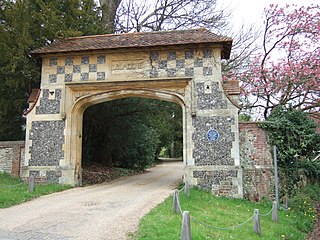
Westhumble is a village in south east England, approximately 2 km (1.2 mi) north of Dorking, Surrey. The village is not part of a civil parish, however the majority of the settlement is in the ecclesiastical Parish of Mickleham.

Ranmore Common, also known as Ranmore Commons, is an area of wooded former common land on the North Downs, immediately northwest of Dorking in the English county of Surrey. Its civil parish is Wotton, a geographically large village with a small population west of Dorking. Ranmore Common is within the Surrey Hills Area of Outstanding Natural Beauty, and part of it is Ranmore Common SSSI, a Site of Special Scientific Interest.
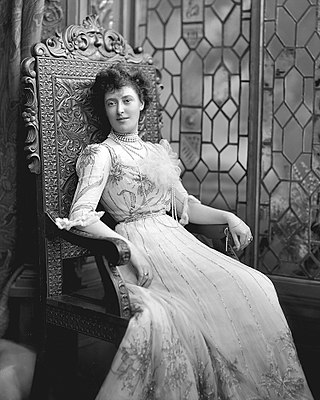
Dame Margaret Helen Greville,, was a British society hostess and philanthropist. She was the wife of the Hon. Ronald Greville (1864–1908).

Betchworth Castle is a mostly crumbled ruin of a fortified medieval stone house with some tall, two-storey corners strengthened in the 18th century, in the north of the semi-rural parish of Brockham. It is built on a sandstone spur overlooking the western bank of the River Mole in Surrey in England.

St. Matthew Friday Street was a church in the City of London located on Friday Street, off Cheapside. Recorded since the 13th century, the church was destroyed in the Great Fire of 1666, then rebuilt by the office of Sir Christopher Wren. The rebuilt church was demolished in 1885.

Norbury Park is an area of mixed wooded and agricultural land surrounding a privately owned its Georgian manor house near Leatherhead and Dorking, Surrey. On the west bank of the River Mole, it is close to the village of Mickleham.

Charles-Frédéric Mewès was a French architect and designer.

The Howard of Effingham School is a co-educational secondary school and sixth form with academy status. It is located in the village of Effingham, Surrey, to the west of Little Bookham. The school is part of the Howard Partnership Trust, a Multi-Academy Trust which includes four secondary and five primary schools.

William McEwan was a Scottish politician and brewer. He founded the Fountain Brewery in 1856, served as a member of parliament (MP) from 1886 to 1900, and funded the construction of the McEwan Hall at the University of Edinburgh.

Hon. Ronald Henry Fulke Greville MVO was an English Conservative Party politician. He was Member of Parliament (MP) for Bradford East from 1896 to 1906.
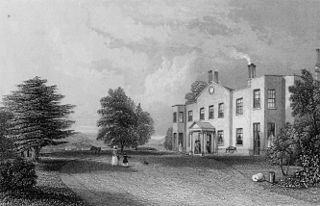
Denbies is a large estate to the northwest of Dorking in Surrey, England. A farmhouse and surrounding land originally owned by John Denby was purchased in 1734 by Jonathan Tyers, the proprietor of Vauxhall Gardens in London, and converted into a weekend retreat. The house he built appears to have been of little architectural significance, but the Gothic garden he developed in the grounds on the theme of death achieved some notoriety, despite being short-lived. The estate was bought by Lord King of Ockham following Tyers's death in 1767, and the macabre artefacts he had installed, including two stone coffins topped by human skulls, were removed.
Siân Evans is a Welsh historical author, journalist, and film consultant, known for her guidebooks for the National Trust, of which she has written seven, and her works of social and cultural history. She has written a biography of Dame Margaret Greville and an account of six society hostesses in Britain between the World Wars.
Sir Walter Rockcliffe Farquhar, 3rd Baronet JP DL was an English landowner of Scottish heritage.








